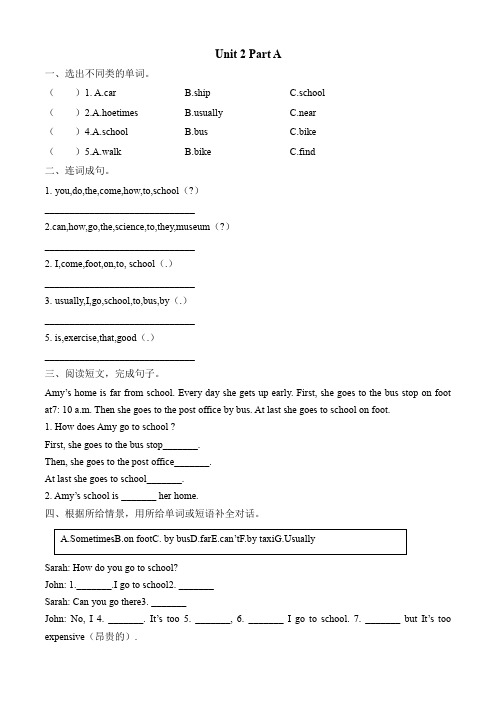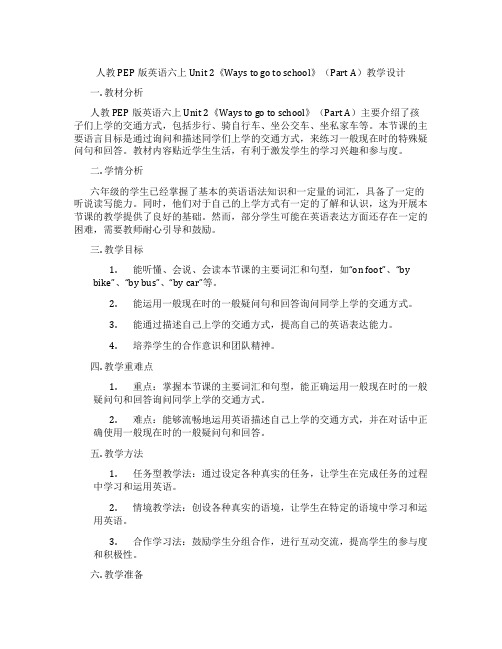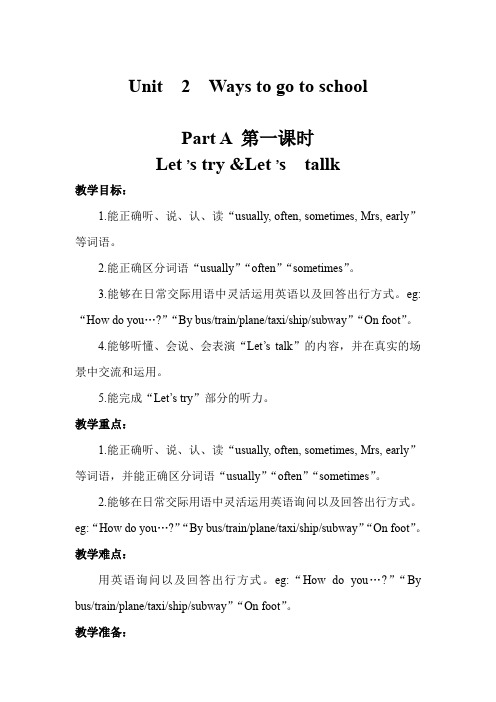六年级上英语二单元Part A (1)
人教版英语六年级上册Unit2 Part A练习题及答案

Unit 2 Part A一、选出不同类的单词。
()1. A.car B.ship C.school()2.A.hoetimes ually C.near()4.A.school B.bus C.bike()5.A.walk B.bike C.find二、连词成句。
1. you,do,the,come,how,to,school(?)______________________________2.can,how,go,the,science,to,they,museum(?)______________________________2.I,come,foot,on,to, school(.)______________________________ually,I,go,school,to,bus,by(.)______________________________5. is,exercise,that,good(.)______________________________三、阅读短文,完成句子。
Amy’s home is far from school. Every day she gets up early. First, she goes to the bus stop on foot at7: 10 a.m. Then she goes to the post office by bus. At last she goes to school on foot.1. How does Amy go to school ?First, she goes to the bus stop_______.Then, she goes to the post office_______.At last she goes to school_______.2. Amy’s school is _______ her home.四、根据所给情景,用所给单词或短语补全对话。
六年级上册英语随堂练习Unit 2 Part A(含答案)

Part A第一课时一、选出不同类的单词。
()1.A.bike B.bus C.by()e B.often C.walk()3.A.sometimes B.exercise ually()4.A.how B.talk C.go()5.A.Mrs B.Mr C.Mary二、单项选择。
()1.There are three_______over there.A.childB.childrensC.children()2.I often go to the zoo_______bike.A.onB.toC.by()3.I_____go to the cinema with my ually we go there on Saturdays.A.taxiB.sometimesC.ship()4.What are they________about?A.talkB.talkingC.talks()5.I usually come to school________.A.on footB.by the busC.by a car三、根据图片或汉语提示,完成对话。
1.—How do you come to school?—_______________________________2.—Where do they want to go?—_________________________________3.—How will they go?—_________________________________4.—Does he go to school on foot?—_________________________________5.—What are they talking about?—_________________________________(他们正在谈论一场运动会。
)参考答案Part A第一课时一、1.C2.B3.B4.A5.C二、1.C2.C3.B4.B5.A三、1.I come to school by bike.2.They want to go to the hospital.3.They will go by bus.4.Yes,he does.5.They are talking about a sports meet.Part A 第二课时听力部分一、听录音,判断下列图片与所听内容是(T)否(F)相符。
人教版六年级上册英语《Unit2PartALet'stry-Let'stalk(2)》说课稿

人教版六年级上册英语《Unit 2 Part A Let’s try-Let’s talk (2)》说课稿一. 教材分析人教版六年级上册英语《Unit 2 Part A Let’s try-Let’s talk (2)》是一篇关于日常生活中的交际对话。
本节课的主要内容是让学生掌握一般现在时的疑问句和回答,以及如何运用一般现在时描述日常生活中的动作和习惯。
教材通过图片和对话的形式,让学生在真实的情境中学习英语,提高他们的语言运用能力。
二. 学情分析六年级的学生已经具备了一定的英语基础,他们对学习英语有着浓厚的兴趣。
但同时,部分学生在语言表达和听力理解方面还存在一定的困难。
因此,在教学过程中,我们需要关注这部分学生的需求,帮助他们提高英语水平。
三. 说教学目标1.知识目标:学生能够掌握一般现在时的疑问句和回答,学会用一般现在时描述日常生活中的动作和习惯。
2.能力目标:学生能够听懂并参与日常生活中的交际对话,提高他们的语言运用能力。
3.情感目标:培养学生热爱生活,关注周围人的情感态度。
四. 说教学重难点1.教学重点:一般现在时的疑问句和回答,以及如何运用一般现在时描述日常生活中的动作和习惯。
2.教学难点:一般现在时的疑问句的构成和运用,以及听力理解。
五. 说教学方法与手段1.教学方法:采用情境教学法、交际法、任务型教学法等,让学生在真实的情境中学习英语,提高他们的语言运用能力。
2.教学手段:利用多媒体课件、图片、录音机等教学辅助工具,激发学生的学习兴趣,提高他们的听力理解能力。
六. 说教学过程1.热身(5分钟):通过唱英文歌曲、做游戏等方式,激发学生的学习兴趣,营造轻松愉快的课堂氛围。
2.导入(10分钟):展示图片,引导学生谈论日常生活中的一些动作和习惯,为新课学习做好铺垫。
3.讲解(15分钟):讲解一般现在时的疑问句和回答,让学生通过实践操练,掌握一般现在时的运用。
4.听力理解(15分钟):播放对话录音,学生听后回答问题,提高他们的听力理解能力。
人教PEP版英语六上Unit 2《Ways to go to school》(Part A)教学设计

人教PEP版英语六上Unit 2《Ways to go to school》(Part A)教学设计一. 教材分析人教PEP版英语六上Unit 2《Ways to go to school》(Part A)主要介绍了孩子们上学的交通方式,包括步行、骑自行车、坐公交车、坐私家车等。
本节课的主要语言目标是通过询问和描述同学们上学的交通方式,来练习一般现在时的特殊疑问句和回答。
教材内容贴近学生生活,有利于激发学生的学习兴趣和参与度。
二. 学情分析六年级的学生已经掌握了基本的英语语法知识和一定量的词汇,具备了一定的听说读写能力。
同时,他们对于自己的上学方式有一定的了解和认识,这为开展本节课的教学提供了良好的基础。
然而,部分学生可能在英语表达方面还存在一定的困难,需要教师耐心引导和鼓励。
三. 教学目标1.能听懂、会说、会读本节课的主要词汇和句型,如“on foot”、“bybike”、“by bus”、“by car”等。
2.能运用一般现在时的一般疑问句和回答询问同学上学的交通方式。
3.能通过描述自己上学的交通方式,提高自己的英语表达能力。
4.培养学生的合作意识和团队精神。
四. 教学重难点1.重点:掌握本节课的主要词汇和句型,能正确运用一般现在时的一般疑问句和回答询问同学上学的交通方式。
2.难点:能够流畅地运用英语描述自己上学的交通方式,并在对话中正确使用一般现在时的一般疑问句和回答。
五. 教学方法1.任务型教学法:通过设定各种真实的任务,让学生在完成任务的过程中学习和运用英语。
2.情境教学法:创设各种真实的语境,让学生在特定的语境中学习和运用英语。
3.合作学习法:鼓励学生分组合作,进行互动交流,提高学生的参与度和积极性。
六. 教学准备1.准备课件和教学素材,如图片、视频等。
2.准备教材和练习册。
3.准备录音机和录音带(或使用多媒体设备)。
4.准备黑板和粉笔。
七. 教学过程1.导入(5分钟)利用课件展示各种交通方式的照片,引导学生谈论自己上学的交通方式。
六年级英语上册教案Unit 2 Part A 人教版PEP

Unit 2 Ways to go to school?Part A单元教材内容:本单元为教材第二单元,围绕“Ways to go to school”这一话题询问别人的出行方式,该话题是学生比较感兴趣的话题,在实际生活中使用较广,与生活联系十分紧密。
六年级学生已经掌握了一些关于交通工具的词汇和常见的表达去某地的动词词组。
在本单元的学习中,重点通过听、说、读、写等活动使学生掌握本单元主要交际语言:How do you come to school? Usually, I come on foot.等交际用语和相关功能词汇,并能通过学习,进一步开发学生的语言交际能力,使其与别人就交通工具的话题进行交流,并比较中西方文化的差异。
单元教学目标:【知识与能力目标】1.能够掌握本单元出现的by, bus, plane, ship, train, helmet, sled, ferry, fast等29个单词和词组,并能熟练朗读与应用。
2.通过对话学习谈论交通出行的主要句型。
如:How do you come to school? Usually, I come on foot. Don’t go at the red light. 并准确熟练的运用于实际交流当中。
3.通过语言学习以及多种形式的交际活动,能够掌握本单元的词汇和主要句型,并能在实际生活中询问他人的出行方式,形成良好的语言交际习惯。
【过程与方法目标】1.能够在情境中进行真实交际。
2.能够自主阅读并总结有效的学习方法。
【情感态度价值观目标】1.通过本课学习,培养学生主动用英语交际的习惯和环保意识。
2.通过学习了解中西方出行方式的异同,发展学生跨文化交际意识。
第一课时1.教学内容:Main scene/A Let’s try/ Let’s talk2.教学目标:(1)能够正确听、说、朗读‘How do you come to school?’询问别人的出行方式;并能够用句子”I come by...”进行回答。
20年秋人教版六年级英语上册第二单元《Ways to go to school》课时练习含答案

20年秋人教版六年级英语上册第二单元《Ways to go toschool》课时练习含答案Unit 2 Part A 第一课时(Let's learn-Write and say)一、听录音,圈出你所听到的单词。
1. A.by plane B. by train C. by taxi2. A. by ship B. on foot C. by bus3. A. hospital B. cinema C. bookstore4. A. Italian B. China C. street二、听录音,标号。
( ) ( ) ( ) ( )三、给下列短语选出合适的图片。
()1.by plane ()2.by bus ()3. by ship ()4.by taxiA. B. C. D.四、单项选择。
()1. — _______do you get to Paris?— By plane.A.WhatB.HowC.Whee()2. Usually I go to school _______foot.A.inB.onC.by()3. You can get to there_______. It’s too tar.A.by planeB.by trainC.on foot()4.My father_______ to work by busA.goB.goingC.goes()5.How do you get to the USA_______ China?A. toB.byC.from五、根据所给情景,用所给单词或短语补全对话。
Sarah: How do you go to school?John: 1._______.I go to school2. _______Sarah: Can you go there3. _______John: No, I 4. _______. It’s too 5. _______, 6. _______ I go to school. 7. _______ but It’s too expensive(昂贵的).答案一、1.A 2.A 3.C 4.B二、2143三、1.A 2.D 3.C 4.B四、1.B2.B3.C4.C5.C五、1.G2.C 3.B 4.E 5.D 6.A听力材料一、听录音,圈出你所听到的单词。
六年级上册第二单元教案

Unit 2 Ways to go to schoolPart A 第一课时Let ,s try &Let ,s tallk教学目标:1.能正确听、说、认、读“usually, often, sometimes, Mrs, early”等词语。
2.能正确区分词语“usually”“often”“sometimes”。
3.能够在日常交际用语中灵活运用英语以及回答出行方式。
eg:“How do you…?”“By bus/train/plane/taxi/ship/subway”“On foot”。
4.能够听懂、会说、会表演“Let’s talk”的内容,并在真实的场景中交流和运用。
5.能完成“Let’s try”部分的听力。
教学重点:1.能正确听、说、认、读“usually, often, sometimes, Mrs, early”等词语,并能正确区分词语“usually”“often”“sometimes”。
2.能够在日常交际用语中灵活运用英语询问以及回答出行方式。
eg:“How do you…?”“By bus/train/plane/taxi/ship/subway”“On foot”。
教学难点:用英语询问以及回答出行方式。
eg:“How do you…?”“By bus/train/plane/taxi/ship/subway”“On foot”。
教学准备:人物头饰、教学光盘、单词卡片教学过程:Step 1:Warm-up1.全班同学一起唱“How do you get there?”,进入学习英语的氛围。
2.学生开火车认读单词词组“on foot”“by bus/train/ship/subway/plane/taxi”。
Step 2: Presentation1.学习新单词。
T:出示图片“Miss”为“小姐,女士”,那么“已婚女士”怎么称呼呢?出示“Mrs”。
T:“早起的鸟儿有虫吃,希望大家以后早到学校,将英语大声说出来”。
六年级上册英语课件-Unit 2—Part A|人教(PEP)

B. Usually I walk to school.
C. How do you come to school?
D. Do you come to school by bike?
E. I’m sorry to hear that.
F. It’s fast.
Oliver: Hey, John. Today is a nice day. John: You’re right. 1._____ C
comes by bus. That’s fast. Mrs smith sometimes
by car, but she usually comes comes to school 8._____ on foot. That’s good 9._________. exercise
三、Read and choose. 请选择恰当的句子补全对话, 并将其字母编号写在横线上。 A. What about you?
Oliver: I come to school by bus today. Usually I come
by bus. 2._____ A
John: 3._____ B But today I come by my mother’s car.
4._____ F
Oliver: How about your sister? She’s not coming
in the 3.________. morning They come to school 4.________ early
today. Mike often 5._______ comes to school by bike. Amy
usually 6.________ she walks to school. 7._____________ Sometimes
六年级英语上册第二单元Part A 部分练习题

六年级英语上册第二单元课课练Part A一、听录音。
根据所听内容给下列图片排序号。
( ) ( ) ( ) ( ) ( )二、听录音,判断下列句子与所听内容是否一致。
一致的在题号前面的括号里填“T”,不一致的填“F”。
( ) 1. They will go to the nature park.( ) 2. Mike usually comes to school by bike.( ) 3. Mrs Smith usually comes to school on foot.( ) 4. I usually get to the UK by plane.( ) 5. I go to Beijing by train.三、听录音,根据所听内容完成下面的表格。
将所听到的交通方式填在人物后面的对应的方框里。
Name transportationMikeSarahJohnWu YifanMr JonesA. sometimesB. ChinaC. trainD. subwayE. CanadaF. oftenG. taxiH. planeI. UKJ. alwaysbus__________________usually_______________USA_________________五、单项选择。
将正确选项的序号填在题号前面的括号里。
( ) 1. —____________ —I come on foot.A. How can I get there?B. How do you come to school?C. Where is your school?( ) 2. I usually go to school _____ bike. Sometimes I go ______ foot.A. by, byB. on, byC. by, on( ) 3. —How do you _____ the USA from China? —By plane.A. getB. get toC. go( ) 4. —How do you go to school? —___________on foot.A. Usually IB. Usually I goC. Usually I go to( ) 5. They ________ about a sport meet now.A. are talkingB. are talkC. talking六、判断下列图片与句子描述是否相符。
六年级英语上册教案Unit 2 Part A(人教) 人教版PEP

Unit 2 Ways to go to schoolPart A本课是人教版六年级上册第二单元A部分,包含三部分内容L et’s learn, Let’s talk & Let’s try。
六年级的学生属于小学阶段中的高年级,他们好奇、好动、表现欲旺盛,已经掌握了一定的词汇和句型,初步具备了用英语进行简单交流的能力,对英语交流也产生了一定的兴趣,已有了初步的合作,自主交流的意识,但离灵活应用所学语言知识,深入体会,拓展学习方面还欠缺很多,所以这个单元将注重学生对生活中的英语运用能力的培养。
【知识目标】1. 能够听、说、读、写短语:on foot,by taxi,by bus,by train, by plane,by ship,by subway;2. 能够正确听说朗读“How do you come to school?”询问别人的出行方式,并能够用句子“I come by…进行回答。
【能力目标】能够正确使用上述单词和词组谈论交通方式。
如句型:How do we get there? Let’s go to the..【情感目标】进一步培养学生学习英语的兴趣和敢于开口、勇于运用的习惯。
【教学重点】掌握运用某种交通具去某地的表达法。
【教学难点】学习句子How do you come to school?I usually/sometimes/often come on foot.Tape recorder, MultimediaStep 1. Warm-up老师呈现分别呈现小鸭子、小猴和小熊骑车的图片,引导学生回答How do you go to school? Step 2. Presentation1.Let's learn(1)教师接上一环节:My home is far from our school. So I often go to school by bus. Do you go to school by bus?同法教授by bike, by car, by taxi, by bus, on foot.(2)师生互动学习chant有关How do you go to school.(3)看图回答如何到达杭州:by plane, by ship, by train.并总结ai的音标发音。
人教版六年级上册英语 Unit 2 Part A 一课一练(含答案)

人教版六年级上册英语 Unit 2 Part A 一课一练(含答案)一、选出与其它不同类的单词1.()A.how B.what C.exercise2.()A.sometimes B.usually C.near3.()A.school B.bus C.bike4.()A.walk B.bike C.find5.()A.car B.ship C.school二、写出相应的短语步行乘公共汽车乘飞机乘地铁乘出租车乘船三、单选题1.— _______ do you get to Paris?— By plane.A.What B.How C.Where2.You can get there _______. It's not far.A.by plane B.by train C.on foot3.My father _______ to work by busA.go B.going C.goes4.Usually I go to school _______ foot.A.in B.on C.by5.How do you get to the USA_______ China?A.to B.by C.from四、选词填空(词汇运用)1. (Sometime/ Sometimes) I go to school by bike.2.(How/ What) do you go to school?3.Usually I go to work (on/ by) foot.4.What (about/ but) you, Amy?5.I usually go to school by (ship/ sheep).五、连词成句1.can, how, go, the, science, to, they, museum(?)2.I, come, foot, on, to, school(.)3.is, exercise, that, good(.)4.you, do, the, come, how, to, school(?)六、阅读短文,完成表格。
人教版六年级英语上册作业课件Part A 第1课时 Let's try-Let's talk

四、下面这些同学分别遇到了不同的事情, 想象一下他们会是怎样的 心情。选一选吧!
( B ) 1. What’s this cartoon about?
( E ) 2. How do you feel?
( D ) 3. How does Sarah feel?
( C ) 4. What will they do?
( A ) 5. Why does the cat chase mice?
三、按要求完成下列各题。
1. They are at school. (对画线部分提问) __W ___h_e_r_e__a_r_e__t_h_e_y_?____
2. They will watch cartoons. (对画线部分提问) __W ___h_a_t__w_i_ll__t_h_e_y__d_o_?____
A. afraid B. h。
A. Because they hurt people. C. They will watch TV. E. I feel happy.
B. It’s about a monkey. D. She feels angry.
( D ) 1. I’m Lily. I lost my little cat. ( A ) 2. I’m Lucy. I see a snake. ( C ) 3. I’m Tom. My mother is ill. She is in the hospital
2023年湘少版六年级英语上册Unit 2第一课时(Part A, Part B)

Katie always gets up early.
On weekdays, she always Her family often has
gets up at 6:30 a.m.
Fri.
6:30 a.m.
Katie __g_e_ts__u_p_ aeta6rl:y3.0 a.m.
Katie __a_lw_a__ys_ gets up at 6:30 a.m. 总是、经常
wave goodbye
挥手告别
挥手
She always _w_a_v_e_s__g_o_o_d_b_y_e_ to her mother.
在……之后
Katie often ______ after dinner.
take a walk 散步
tips: always often
sometimes never
总是 经常 有时 从不
频率副词:频 率副词是表示 与次数、频率 有关的副词。
频率副词用在be动词后,实义动词前,还用在 助动词与实义动词之间。对频率提问用how often或 how many times。
at eight o'clock at night at weekends
in
后接上午/下午/晚上/ 季节等
in the morning/ afternoon/evening in spring
She plays chess with her father after dinner.
讲解: • 这是一个一般现在时的肯定句,用来描述他人
- 1、下载文档前请自行甄别文档内容的完整性,平台不提供额外的编辑、内容补充、找答案等附加服务。
- 2、"仅部分预览"的文档,不可在线预览部分如存在完整性等问题,可反馈申请退款(可完整预览的文档不适用该条件!)。
- 3、如文档侵犯您的权益,请联系客服反馈,我们会尽快为您处理(人工客服工作时间:9:00-18:30)。
教学重点与难点
本课时的教学重点
能听、说、读、写on foot、by bus、by train、by plane、by subway、by ship、by bike、on foot 、by taxi等词组; 能在情境中运用句型:How do you come / go…? I usually/sometimes/often come/go… 本课时的教学难点 掌握用某种交通工具去某地的表达法。
Part A
Look, this is me on my bike. I usually go to work by bike. Do you have a bike? How do you usually come to school?
Do you often/usually come to school by bus/ car or …?
3.Answer questions.
How does Mike come to school? He often comes to school by bike .
How does Amy come to school? She usually comes to school on foot and sometimes by bus .
Listen and check.
1. Read the the words. 2. Listen to the story.
3. Answer questions. 4. Talk in pairs.
What are they going to do? They are going togo to the nature park.
Do they go there by plane/bus?
No, they don't . / Yes, they do. How do you come to school today? I come to school …today. What about you?
1.Listen to the story. 2.Read in pairs.
Look and talk!
Look, do you know who they are? Where are they?
They are Mike and Amy. They are in front of the school.
Are they on their way to school?
How does the boy go to school?
Yes, they are.
He goes to school by bike.
Today we are going to talk about different ways to go to school.
Unit 2 Ways to go to school
Part A
教学内容
P13: Main content
P14: Let's try Let's talk
P15: Let 's learn Write and say
教学目标
能听、说、读、写单词和词组by plane, by train , by taxi, by ship , on foot, by bus, by subway;
on foot
by bus
by taxi
by plane
by ship
by subway by train
by car
介词by
by bus by taxi by subway by train by plane by ship
介词on
on foot
Read the two questions. Predict what's going on(what is a sports meet/ guess how do they go there).
2. Do “Write and say” by themselves.
3. Talk in groups.
for example: T: How do you get to the USA from China? S: By plane. T: How do you get to your school from your home? S: On foot. T: How do you get to the park from the supermarket? S: By 教师呈现自己骑自行车/开车或乘坐其他交通工具上班的照片并利用已知单词car 、bus等引导学生思考自己上学时的交通工具
Presentation & Practice 用图片或者课件的形式呈现本课新词汇、新句型 讲解介词by与on的使用 Let's learn 对话练习 Let's try 听力练习 Let's talk 整体感知,小组学习,巩固总结
How does Mrs Smith come to sSchheosool?metimes comes to school by car but uaually walk .
Do they come/go to school on foot/by subway? Yes, __comes to school on foot/ by subway. / No, they don't.
Production: Do “Write and say”
Free talk!
Look, this is me on my bike. I usually go to work by bike. Do you have a bike? How do you usually go to school?
4. Circle,underline and take notes.
usually often sometimes
80% 60%
20%
early 早到的
walk=on foot
Do a survey
1. Listen to the audio 2. Finish it in groups
1. Demo by teacher(get to __from__ / how).
